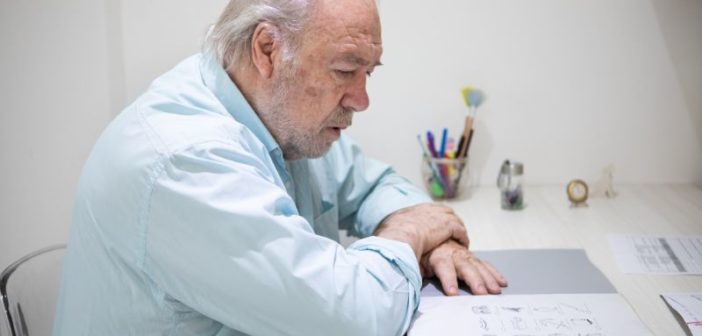Mild cognitive impairment (MCI) is the term medical professionals use to describe a person’s first stage of memory loss or mental decline.
According to recent studies, between 12-18% of people over 60 cope with this condition. Experts also believe that 10-15% of people with MCI develop dementia every year and that one-third of people living with MCI due to Alzheimer’s disease will develop dementia in less than five years, if distinctive indications in the brain are evident. For me, these statistics are entirely unacceptable because the potential for better diagnosis, treatment, and outcome already exists today.
The origin of eye movement tracking for neurodegenerative disease diagnosis
Several years ago, I had the good fortune to meet my colleague and co-founder Sai Mattapalli as a freshman at Thomas Jefferson High School for Science and Technology in Alexandria, Virginia. Within minutes, we discovered a mutual fascination with AI and other forms of cutting-edge technology and science. That was the meeting that sparked the beginning of our somewhat atypical high-school careers.
While working with various incubation groups, I developed a keen interest in the link I saw forming between rapidly advancing AI in the tech sector and its potential use in the field of medicine.
That connection opened my eyes to a future in which a medical diagnosis would be proactive, rather than reactive. This future is here today, and it is possible thanks to AI’s ability to track digital biomarkers, including physiological and behavioral information such as our heart rates, sleep patterns, and daily step counts. Anyone today can easily collect these markers with affordable digital devices like smartwatches.
In a nutshell, eye tracking assumes that our eyes are a “window” into how our brains are functioning at any given moment. Their movement serves as a biomarker that can give us an early warning of neurological problems.
I first developed a prototype of a device that could track eye movement and turn the data into actionable information about a person’s brain health, then filed a provisional patent and approached Mattapalli with the idea of launching a startup firm. My friend was no stranger to the field of neuroscience. In fact, he had already completed advanced research in the field while at Georgetown.
Our vision is an accessible and affordable technology that anyone can use to detect ocular indicators for neurodegenerative diseases like Alzheimer’s.
How AI tracks eye movement and offers rapid diagnosis
Algorithms powered by artificial intelligence can examine mountains of data and spot minor patterns that point to developing neurological problems. Early detection is paramount in the effort to manage disease progression when it comes to disorders like Alzheimer’s, and early diagnosis from a wearable device like Vytal.ai would allow unprecedented improvements in treatment.
Today, we see a gross under-diagnosis rate for MCI in primary care settings and Alzheimer’s disease. This lack of adequate cognitive screening at the primary care level leads to a notable absence of therapy and proper care for dementia patients. Vytal.ai will one day soon allow patients to screen for conditions like Alzheimer’s from the comfort of their own homes. This is significant, since recent FDA-approved drugs have shown to reduce the progression of Alzheimer’s disease if administered in time.
The fact is that the tech industry markets primarily to younger generations. Unfortunately, older adults at the age of contracting disorders like Alzheimer’s are all too frequently neglected by technological advances. Our hope is that a device such as this will give this population more agency.
AI tracks eye movement to offer data-driven insights and individualized care
The brain is an infinitely complex organ. As humans, we lack the capacity to monitor and analyze its daily function. When it comes to neurodegenerative illnesses and potential treatments, AI’s ability to evaluate vast datasets greatly improves our understanding of brain health.
AI has the power to process vast stores of information, and it can do so for thousands of individuals at a time. With AI, we can obtain the individual patient data we need to recommend tailored treatment plans and optimize outcomes for patients with a number of brain-related conditions. Once our platform is released, it could become an indispensable tool in quantifying brain health and identifying cognitive decline at an early stage — both of which can inform personalized care and treatment decisions.
Employing AI in remote monitoring of brain health
Wearable gadgets equipped with AI enable people “on the go” to obtain constant monitoring of brain health at all times of day. These devices provide immediate feedback and make preventative measures easier to implement.
The concept of using eye movement to monitor brain health is not novel. In fact, a number of pricey devices can already measure eye movements to check cognitive performance. Our vision, however, is a device that is easy to implement and inexpensive. In designing a device that is accessible to everyone, we stumbled upon a revolutionary innovation in modern healthcare.
We created our platform to take advantage of the camera on your laptop or smartphone. It can pair with your device to perform eye-tracking and biometric calculations in a matter of minutes, eliminating the need for expensive and cumbersome eye-tracking equipment.
I look forward to a not-so-distant future, where healthcare professionals stay one step ahead of the neurological conditions that proved so crippling in our past. The power of AI, combined with a palm-sized wearable device, is poised to improve the quality of life for millions.
Related News:
How Healthcare Technology Shapes the Lives of People with IDD

